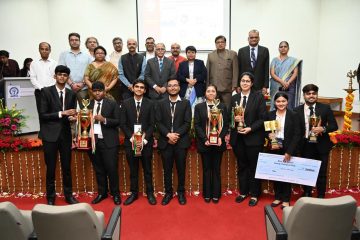 The goal of modern medicine is no longer confined to the mere treatment of sickness. Equally important is disease prevention and improvement of the basic quality of life. This requires knowledge sharing and collaborations among medical profession, architects, administrators, academics and management consultants to help them put forward their view points on the future of healthcare in India.
The goal of modern medicine is no longer confined to the mere treatment of sickness. Equally important is disease prevention and improvement of the basic quality of life. This requires knowledge sharing and collaborations among medical profession, architects, administrators, academics and management consultants to help them put forward their view points on the future of healthcare in India.
A conference on “Hospital Planning and Beyond” organized by the Department of Architecture and Regional Planning of IIT Kharagpur on January 28 in Kolkata brought together experts from the medical profession, architects, administrators, academics and management consultants to put forward their view points on the future of healthcare in India.
“In the symposium entitled ‘Hospital Planning and Beyond’ we explored the issues in the area of modern day healthcare from perspectives of lifestyle, affordability, prevention habits, infrastructure of our habitat and hospitals, and technologies such as integrated medical devices, artificial intelligence. As an architect and urban planner, I think it is important for us to make the cities liveable, thus reducing the need for health services,” explained Prof. Subrata Chattopadhyay, Avinash Gupta Chair Professor at the Department of Architecture and Regional Planning, IIT Kharagpur.
Ms Sumita Bagchi, Joint Secretary, Urban Development and Municipal Affairs, Government of West Bengal, who represented the Principal Secretary, made this association clear when she talked about the necessity to increase the green and blue covers in residential areas and community spaces, and promoting walkways, cycle lanes, battery operated vehicles in the cities to avoid lifestyle diseases and checking pollution. The smart city mission has percolated as the green city mission for smaller townships involving engagement of architects and planners for effective land use, thus reducing health hazards. She also pointed out the unique urban challenges faced by West Bengal in waste management and the alternative means being thought by the government to finance Green City projects.
Mr Sameer Mehta, Director, Projects, HOSMAC India, talked about how insurance companies have become a critical component of the healthcare facilities, and how to preserve the balance between the payer (insurance companies), the provider (hospitals), and the consumer (patient), it is necessary to concentrate on the ‘value’ of healthcare instead of ‘volume’. A patient centric approach to healthcare design and management with a focus on affordable healthcare was a key component of this shift.
Modern medicine today is also seeing an unprecedented confluence of medical and engineering education and research. Assisted technology has not only enhanced learning and skill development in medicine but also added new dimensions to hospital planning and management. In this purview, Dr Dipendra K. Mitra, Head, Department of Transplant & Immunology, AIIMS, Delhi, emphasized on the need of doctors and engineers working together to develop such integrated and AI devices and installing them in government hospitals and rural clinics. He pointed out how AIIMs, along with Azure Software in Kolkata and the Department of Computer Science and Engineering of IIT Kharagpur had developed a cloud based Integrated Medical Device for acquisition of medical data or parameters for early diagnosis, timely intervention aimed at preventing the disease progression. He said that such cloud based IMDs would be game changer in the management of community health for non-communicable diseases in both urban and rural populations. He also pointed out how AIIMS was facilitating the generation of big data in medical sciences so as to enable machine learning and AI based analytics and intervention by the medical fraternity.
The use of advanced technology to facilitate affordable healthcare was further emphasized by Prof. Suman Chakraborty, Head, School of Medical Science and Technology at IIT Kharagpur. The microfluidic based diagnostic devices developed by Prof. Chakraborty could be used at healthcare clinics and diagnostic centres with lesser manpower for carrying on medical tests and generating diagnostic reports which can lead to required medical intervention at a much affordable and convenient manner for a large mass of people with limited healthcare access.
Dr (Prof) Arnab Gupta, Medical Director, and Consultant Surgical Oncologist, Saroj Gupta Cancer Centre and Research Institute, Kolkata dispelled the common misconceptions regarding cancer and insisted on the importance of self-monitoring and tracking in order to defeat cancer. Mr Anjan Gupta, Honorary Secretary and Architect of the Saroj Gupta Cancer Centre and Principal Designer of Anjan Gupta Architects, Kolkata, talked about how the Cancer Centre at Thakurpukur was spreading awareness about cancer in the eastern region of India. He also dealt with the basics of hospital design and planning with reference to Saroj Gupta Cancer Centre.
A panel discussion was held focusing on replacing symptomatic treatment with AI powered diagnostics. A key point which emerged in this discussion was how AI can transform medical consultation based on personal medical history and common medical knowledge, genomics based health diagnosis, virtual caregiving and so on. Principal Secretary, Urban Development and Municipal Affairs, Government of West Bengal, Dr Subrata Gupta, participated in the panel discussion.
The initiative was undertaken under the Avinash Gupta Chair Professorship supported by alumnus Ron Gupta, President of IIT KGP Foundation, USA. A handbook on Creation of a Universally Stimulating and Responsive Environment within Hospitals – A Conceptual Research Model, authored by Prof. Haimanti Banerji, who was the co-convener of the symposium, was launched on this occasion. Tata Trusts, which was the knowledge partner of the event, gave a presentation on cancer awareness, staged a street play on oral cancer, initiated an anti-tobacco pledge, and talked about its plan on the management of cancer at the primary, secondary and tertiary levels in urban as well as rural areas.
Photograph and banner design: Arnab Moitra



